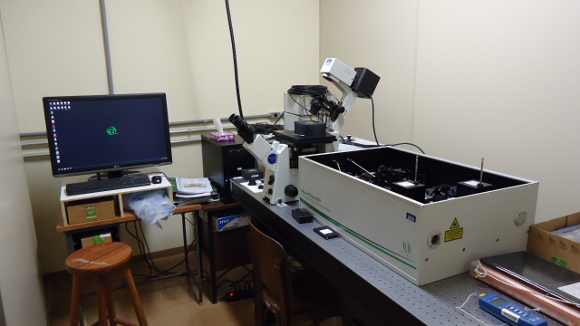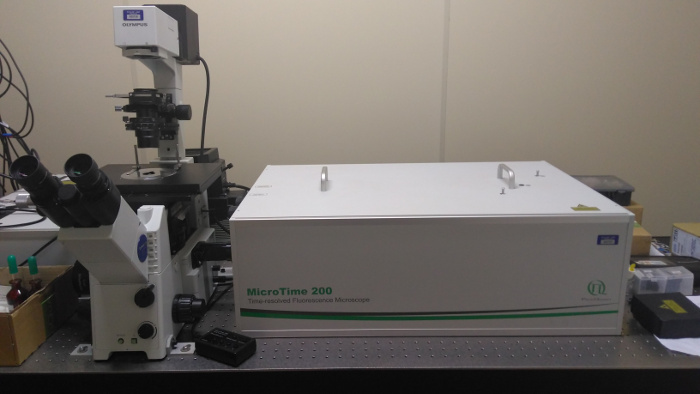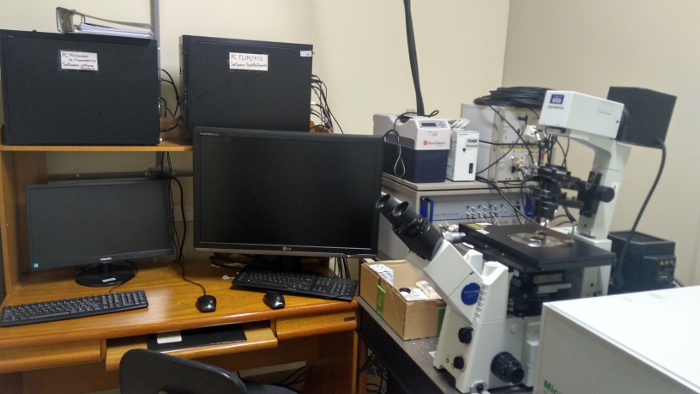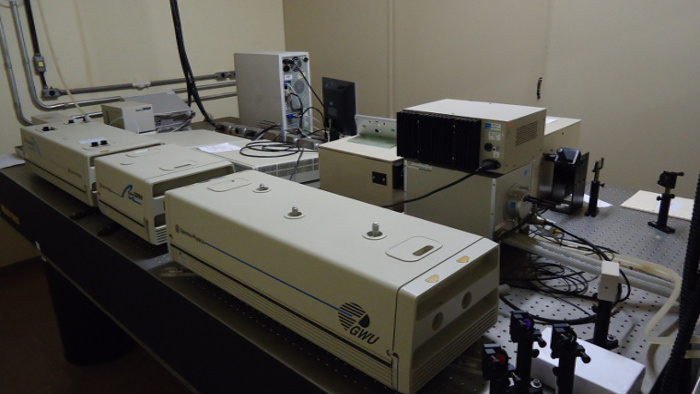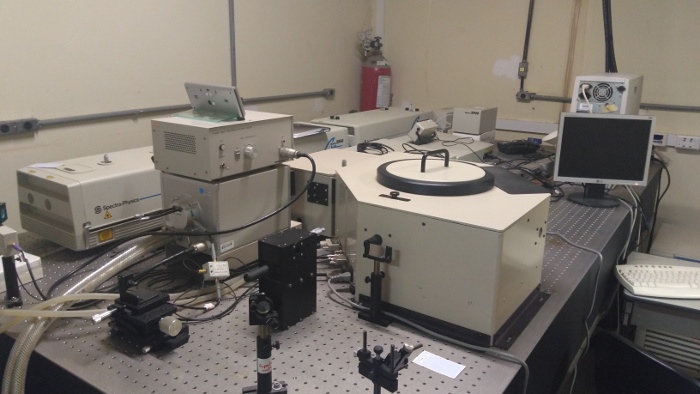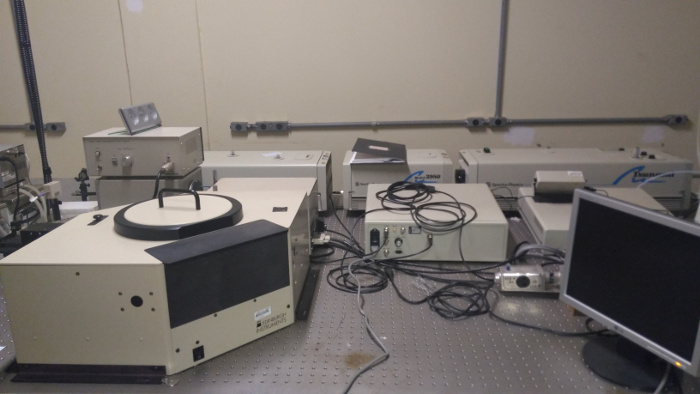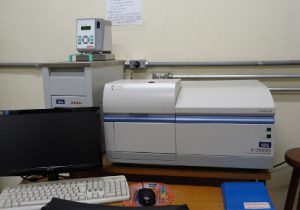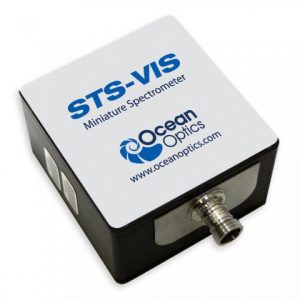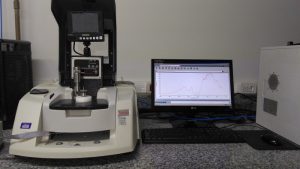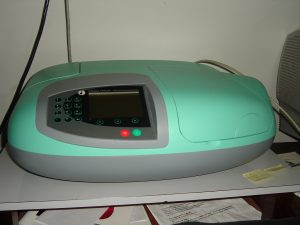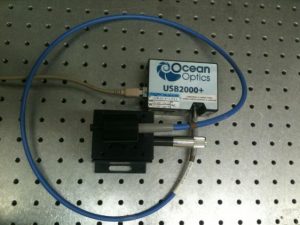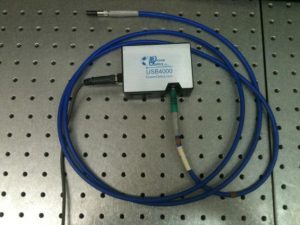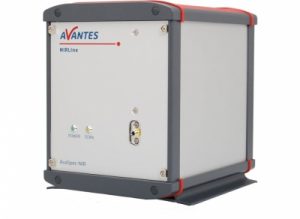1) Time-resolved Fluorescence Microscope
The MicroTime 200 fluorescence lifetime system (PicoQuant) is a powerful multi purpose instrument capable of fluorescence lifetime image (FLIM) and fluorescence correlation spectroscopy (FCS) with single molecule detection sensitivity. FLIM produces an image based on the differences in the excited state decay rate from a fluorescent sample. Thus, FLIM is a fluorescence imaging technique where the contrast is based on the lifetime of individual fluorophores rather than their emission spectra. FCS is a correlation analysis of temporal fluctuations of the fluorescence intensity and consist in the determination of the temporal autocorrelation of fluorescence fluctuations. The analysis of autocorrelation curves allows the determination of the diffusion coefficient of fluorophores at nanomolar concentrations.
A picosecond pulsed laser of the desired excitation wavelength1 is reflected by a dichroic beam splitter into an inverted microscope’s objective2. Fluorescence emission is collected with the same objective, passing through a dichroic to remove scattered light before reaching a pinhole (Thorlabs) for confocal detection. A filter3 is added in the optical path to guarantee only fluorescence emission to be detected with a single avalanche photo diode (SPAD). Fluorescence intensity decay profiles are obtained in the same instrument using the time-correlated single photon counting (TCSPC) technique, and are analyzed by proprietary software of the microscope, SymPhoTime 64, by a non-linear least-squares formalism. The quality of the fit is analyzed from the reduced chi-square values and the residuals distribution. The same software is employed to analyze the temporal correlation of intensity fluctuations in order to obtain the auto-correlation curves and diffusion coefficients.
1 Pulsed diode lasers (PicoQuant) with repetition rates up to 40 MHz: LDH-D-C375, LDH-D-C440, LDH-D-C470, LDH-P-FA530, LDH-D-C640
2 Objectives: PlanN 20×0.4, air; PlanN 40×0.65, air; UplanFl 100×1.3, oil; PlanF 100×0.90, air; UPlanSApo 60×1.2 with correction collar, water.
3 Filters: HQ405 LP; HQ460 LP; BLP01-488R; HQ550 LP; HQ690/70m
The Olympus IX 71 inverted microscope is equipped with bright field, fluorescence (xenon lamp) and differential interference contrast (DIC) optics; and with an Olympus DP73 camera for imaging of histological and fluorescent samples. Olympus CellSens software for standard imaging.
Fluorescence Mirror Unit:
| Unit name | Excitation filter (nm) | Emission filter (nm) | Dichromatic mirror (nm) |
| U-MNU2 | 360-370 | 420 | 400 |
| U-MWB2 | 460-490 | 520IF | 500 |
| U-MWIG3 | 530-550 | 575IF | 570 |
2) Time-resolved Fluorescence
The Tsunami (Spectra-Physics) laser system is mode-locked to provide picosecond pulses of light and is tunable to wavelengths between 840 and 990 nm. The output is pulse-picked and frequency doubled or tripled to generate wavelengths between 280 – 330 nm and 420 – 495 nm, respectively. The pulses are directed to an L-format Edinburgh F900 spectrometer with a monochromator in the emission channel. Single photons are detected by a cooled Hamamatsu R3890U microchannel plate photomultiplier. In anisotropy experiments, a Soleil-Babinet compensator and a Glann-Thomson polarizer are used in the excitation and emission beam, respectively. Data are analyzed by using a commercial software (Edinburgh Instruments) based on non-linear least-squares method. The quality of fit is judged from statistical parameters like reduced chi-square values and the residuals distribution. This system is used for time-resolved spectroscopy and is based on the time-correlated single photon counting method (TCSPC).
3) Static Fluorescence
The Hitachi F-7000 spectrofluorimeter is used to measure emission and excitation spectra of light emitting or fluorescent samples. In addition, the instrument is equipped with a pair of polarizers that allow for the measurement of anisotropy. The sample temperature can be controlled using an external water bath.
4) In situ Fluorescence spectroscopy
A Spectrometer (STS-VIS, Ocean Optics, USA ) is equipped with a 200 microns slit aperture for Fluorescence measurement over the spectral range of 350-800 nm. The spectrometer can be assembled with optical fibers and desirable laser excitation.
5) Fourier Transform Infrared Spectroscopy
Nicolet 380 FTIR spectrometer (Thermo Scientific Inc, Waltham, USA) is equipped with different accessories: 1) Transmittance accessory, including sample support for different sample diameters; 2) Diamond ATR (Attenuated Total Reflectance) accessory (Smart Omni-sampler, Thermo Scientific Inc., Waltham, USA) with a measurement area of 2 mm diameter.
6) UV-Vis spectroscopy
The Ultrospec 2100 pro (Amersham Pharmacia) is a single beam scanning UV-Vis spectrophotometer for routine use. It has a wavelength range from 200-900 nm.
7) Emission spectroscopy – Ultraviolet, Visible and Near-Infrared
The Spectrometers (USB4000 and USB2000, Ocean Optics, Dunedin, USA ) calibrated to measure the spectral irradiance in the range of 290–700 nm equipped with optical fibers and cosine-corrected irradiance probes (CC-3-UV, Ocean Optics, Dunedin, USA).
The spectrometer (AvaSpec-NIR512, Avantes, Netherlands) is calibrated for wavelength and irradiance in the spectral region of 900 – 1750 nm. The entrance optics is CC-VIS/NIR corrector.
8) Diffuse Reflectance spectroscopy
A Xenon ar Lamp and a Tungsten-Halogen light source can be employed to diffuse reflectance spectroscopy in the range of 250-1700 nm. The setup is modular and different spectrometers can be selected for the desired spectral range.
9) Solar Spectral Irradiance at the city of Ribeirão Preto.
We employed a single CCD monochromator (USB2000+UV-Vis-ES, Ocean Optics, USA) preconfigured to 200-850nm, with 25µm slit. A bundle of quartz glass fibers (15 m length and 0.6 mm diameter) couple the spectroradiometer to a weatherproof global entrance optics (UV-J1002-SMA-SHUT, Schreder, Austria). An environmental box (J1025-ENVBOX-01-REG2, Schreder, Austria) with temperature regulation kept the spectroradiometer to 25O ℃. The global entrance is located on the roof of a three-store high building, free of shadows or highly reflective areas. The system was calibrated with a 200 W quartz halogen (KS-J1011-LAMP, Schreder, Austria). The monochromator is controlled by a Matlab® routine that measures the relative intensity of the sun every 15 minutes.
The setup is located in Northwestern São Paulo State, in the city of Ribeirão Preto (-21.167177,-47.848099), at the University of São Paulo Campus. These spectra are published in real-time as row data at the web page of the research center, “Centro de Fotobiologia e Espectroradiometria Ambiental – CFEA”, located at the “School of Pharmaceutical Sciences of Ribeirão Preto – USP”. In the same website, we also provide in real-time the UV-index calculated from the sun spectral irradiance and erythema action spectrum.
10) Portable system for Solar Spectral Irradiance measurement
A portable system to measure the spectral irradiance (250-800 nm) of the Sun employes a single CCD monochromator (Flame, Ocean Optics, USA); A bundle of quartz glass fibers (2 m length and 0.6 mm diameter) couple the spectroradiometer to a weatherproof global entrance optics (UV-J1002-SMA-SHUT, Schreder, Austria). A home-made thermal box with temperature regulation kept the spectroradiometer to 24 ℃. The system was calibrated with a 200 W quartz halogen (KS-J1011-LAMP, Schreder, Austria). The monochromator is controlled by a routine in Phyton and a Raspberry Pi™.
The routine can calculate the UV index from the spectral irradiance.

